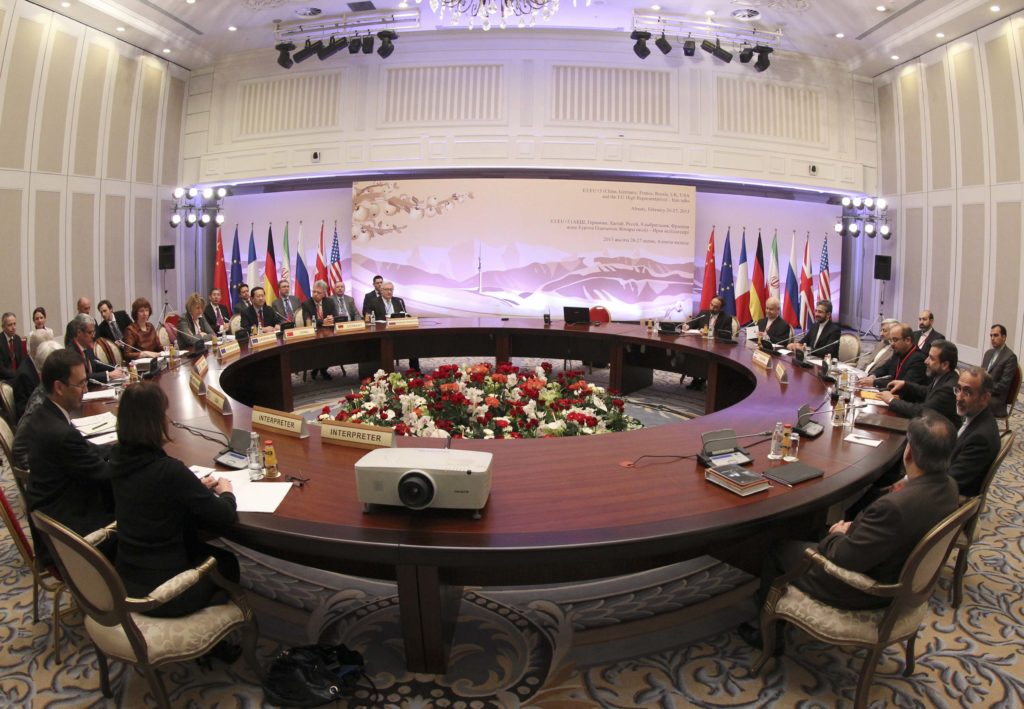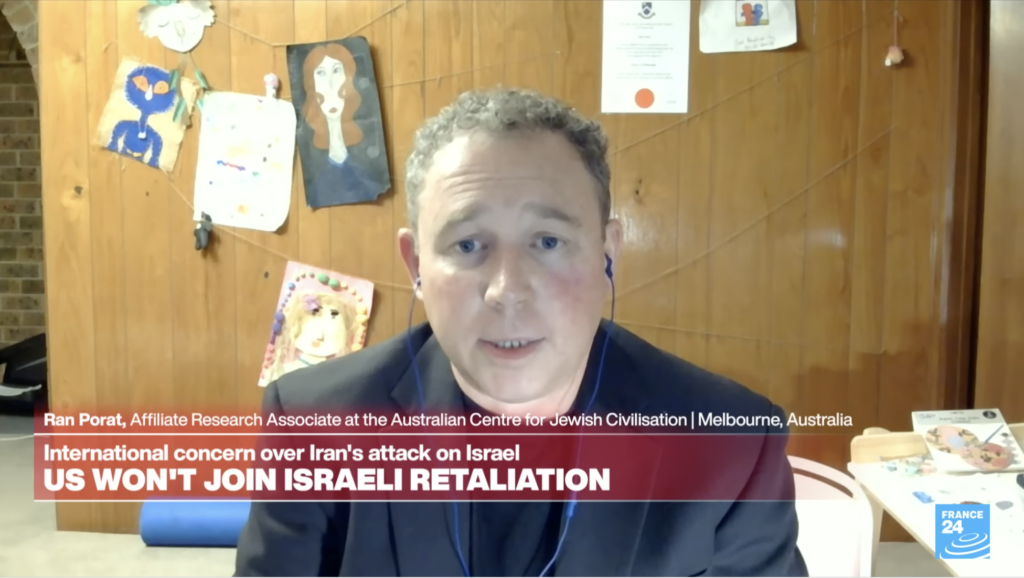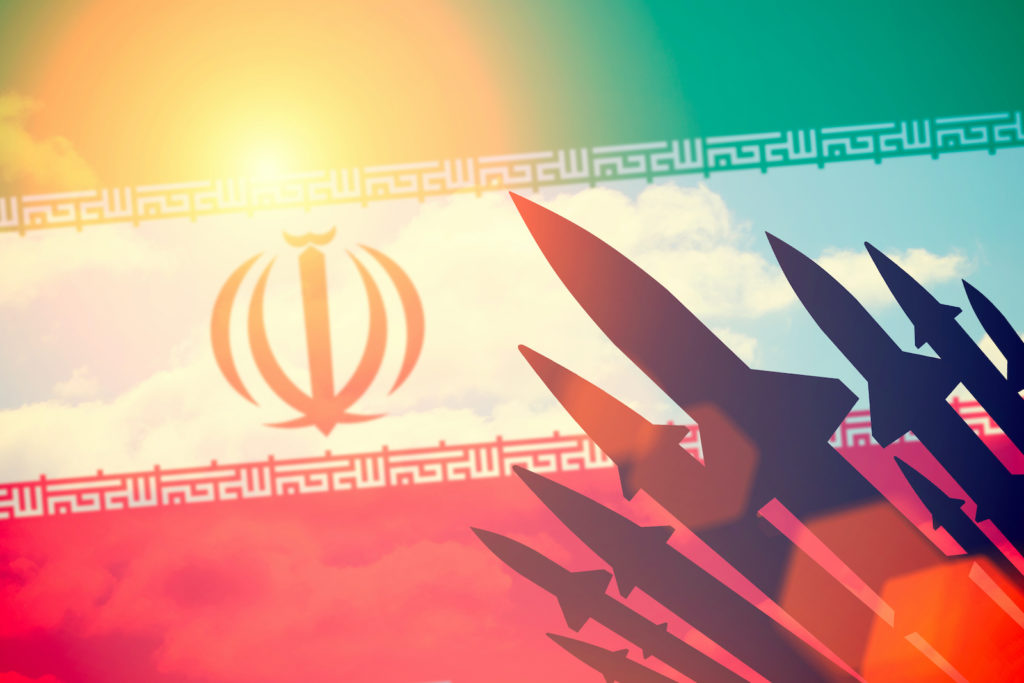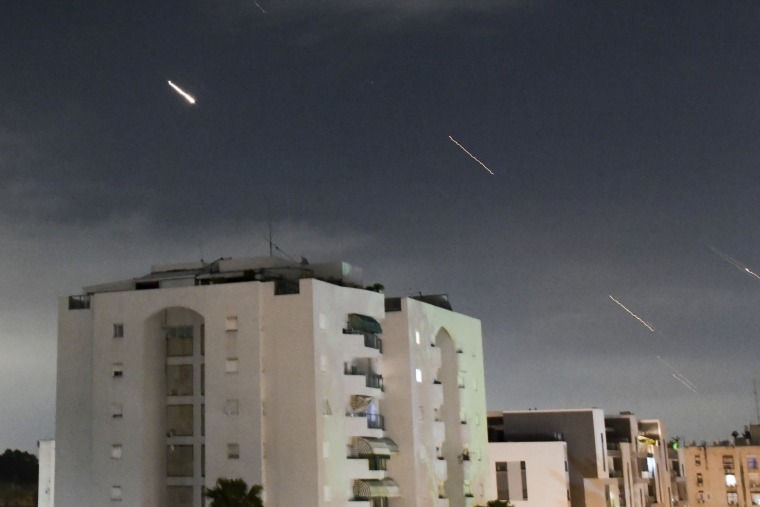UPDATES
Another unsuccessful round of Iran talks/ Israel gets gas
Apr 11, 2013

Update from AIJAC
April 11, 2013
Number 04/13 #02
The latest round of talks over Iran’s nuclear program ended on the weekend with a meeting in Almaty, Kazakhistan, which concluded with little substantive progress and no agreement even about when talks might resume. Moreover, despite Iranian claims to have presented an offer in the latest talks, participants say it was actually, “some interesting, but not fully explained, general comments on our ideas” and an “apparent return to debating modalities for negotiations ” rather than any substantive proposal. Iran then followed up the end of the talks by announcing the opening of two new uranium mines and a yellowcake (uranium oxide) factory. This Update deals with the talks and the current state of the Iranian nuclear crisis.
The first inclusion is a Washington Post editorial which highlights both the failure in Almaty, but also one of the few positives in the whole nuclear crisis – namely, the Iranian decision to abide by the red-lines set out by Israeli PM Binyamin Netanyahu last September. The Post notes that Iran seems to be carefully avoiding making enough medium enriched uranium – that is, uranium enriched to 20% – to make a nuclear bomb, if further enriched. Netanyahu warned enrichment to this level – which is, in terms of technical difficulty, most of the way to bomb grade – in weapon-making quantities would constitute a point of no return with the aid of a much-ridiculed diagram in his September UN talk. While the paper notes that the current Iranian restraint represents only a temporary check on the Iranian threat, it does highlight the need for a credible threat of military action in Western strategy for dealing with Iran, as Netantyahu’s implied threat seems to have been effective in this case. For the paper’s full argument, CLICK HERE.
Next up is Ray Takeyh, an expert on the Middle East from the venerable Council on Foreign Relations, discussing what the final red line for a deal with Iran should be. He is particularly concerned that the P5+1 power not concede to the Iranians demand that their “right to enrich” be recognised, even if Iran offered concessions on the 20% uranium issue. He argues that conceding this “right” would essentially be a way to delegitimise any military option as Iran continued to pursue military nuclear capability. Takeyh urges that the only viable red line is the one set out in several UN Security Council resolutions – which means all enrichment must be curtailed, not just the enrichment to 20%. For his complete argument, CLICK HERE.
Finally, on a separate issue, the Jerusalem Post reviews the promise – and the potential problems and pitfalls – for Israel with the beginning of production last week of natural gas from the Tamar field, the first of two major gas fields discovered off the Israeli coast. The paper canvasses the difficulties of making sure the revenue from the fields are taxed and invested in such a way that the proceeds can be used for the public good, and of making decisions about what percentage of the new gas should be exported. An even bigger question is whether Israel can find a way to escape hatred and boycotts to export its surplus to neighbouring states, such as Jordan and the Palestinians, which would be best for all concerned, and also might build some bridges toward peaceful coexistence. For the paper’s discussion of the implications of Israel’s new energy wealth in full, CLICK HERE. Anyone interested in all the details about the gas fields and their economic and geopolitical implications must read David Wurser’s comprehensive and informed article on the subject at the Jerusalem Centre for Public Affairs. Some more thoughts on the meaning of new gas production for Israel from Elliot Abrams of the Council on Foreign Relations and Jonathan Tobin of Commentary.
Readers may also be interested in:
- Strategic expert Bryan Prior argues that Iran sanctions serve a purpose even if they fail to convince Iran to backtrack on their nuclear program.
- A variety of links are being drawn between the North Korean crisis and the Iranian nuclear issue – good examples come from analysts interviewed by AFP and by the New York Times, as well as a Wall Street Journal editorial.
- Iran expert Ariane Tabatabai takes on Iranian claims that Iranian Supreme Leader Ali Khamanei has issued a fatwa (religious ruling) against nuclear weapons, noting that no text of any such fatwa has even been published and claims being made about what it says are contradictory.
- Michael Rubin urges Israel to consider using its new gas wealth to end receipt of US aid.
- US intelligence sources appear to confirm that the Syrian regime used chemical weapons in the civil war there last month. Meanwhile, reports say that the Syrian regime is training its militia fighters in Iran.
- Judith Miller discusses signs Egypt seems to be perched on the edge of complete chaos, while Eric Trager of the Washington Institute looks at what opposition forces want from the Egyptian military, and the military’s calculated response.
- Terrorism expert Matthew Levitt discusses the conviction of a Hezbollah member for terrorism offences in Cyprus, and its implications for efforts to proscribe Hezbollah within Europe.
- A new report says antisemitic incidents increased 30% globally last year.
- A photo being circulated by Palestinian groups of Maysara Abu Hamdiya, a convicted Palestinian terrorist who recently died of cancer in an Israeli hospital, was photoshopped to make it appear he was handcuffed to his hospital bed.
- Isi Leibler offers some thoughts on the impulse of diaspora Jewish leaders to attempt to tell elected Israeli leaders what to do.
- Talia Katz on how an author on a Fairfax website managed to turn a feel-good story about the success of an Ethiopian immigrant to Israel into an anti-Israel rant based on false claims.
Editorial: Iran heeds Israel’s warning of uranium ‘red line’
THE LATEST round of negotiations on Iran’s nuclear program was, by all accounts, a disappointment. Tehran’s negotiators did not spell out a full response to a proposal by the United States and five partners for limiting its enrichment of uranium, and what they did say revealed a wide gulf between the two sides. In essence, the international coalition is offering Iran a partial lifting of sanctions in exchange for a freeze on the production of medium-enriched uranium, while Iran wants a complete lifting of sanctions in exchange for token steps that would leave its nuclear work unfettered.
The meetings left the diplomatic process in limbo; the Obama administration and its allies rightly refused Iranian requests to schedule further meetings. Yet for now, at least, there is no crisis: Neither Israel nor the United States is under pressure to consider immediate military action against Iran, and there is time to wait and see if Iran’s position will soften following a presidential election scheduled for June.
For that, proponents of diplomacy over war with Iran can thank a man they have often ridiculed or reviled: Israeli Prime Minister Benjamin Netanyahu.
Mr. Netanyahu’s government is not a participant in the talks with Iran, of course; Iran won’t parley with a nation it aspires to “wipe off the map.” But the Israeli leader’s explicit setting of a “red line” for the Iranian nuclear program in a speech to the U.N. General Assembly in September appears to have accomplished what neither negotiations nor sanctions have yielded: concrete Iranian action to limit its enrichment.
A host of commentators both in the United States and Israel scoffed at what they called Mr. Netanyahu’s “cartoonish” picture of a bomb and the line he drew across it. The prime minister said Iran could not be allowed to accumulate enough 20 percent enriched uranium to produce a bomb with further processing, adding that at the rate its centrifuges were spinning, Tehran would cross that line by the middle of 2013.
Iran, too, dismissed what its U.N. ambassador called “an unfounded and imaginary graph.” But then a funny thing happened: The regime began diverting more of its stockpile to the manufacture of fuel plates for a research reactor. According to the most recent report of international inspectors, in February, it had converted 40 percent of its 20 percent uranium to fuel assemblies or the oxide form needed to produce them. As a result, Iran has remained distinctly below the Israeli red line, and it probably postponed the earliest moment when it could cross that line by several months.
Mr. Netanyahu’s red line is only a partial and temporary check on the Iranian threat. The ongoing installation of a new generation of faster centrifuges could soon make it obsolete by providing a new means for Iran to quickly produce bomb-grade uranium. But the lesson here is twofold: The credible threat of military action has to be part of any strategy for preventing an Iranian nuclear weapon, and clear red lines can help create the “time and space for diplomacy” that President Obama seeks. Mr. Obama, who last year stiffly resisted pressure from Mr. Netanyahu to spell out U.S. red lines, ought to reconsider.
Back to Top
————————————————————————
The best red line for a nuclear Iran
Optimism and progress are words seldom associated with diplomatic encounters involving Iran. But Tehran’s seeming interest in negotiations during the recent talks in Kazakhstan has led to hope in Western capitals that perhaps economic sanctions have finally produced a reliable Iranian interlocutor. As the great powers contemplate a solution to the Iranian nuclear conundrum, they would be prudent to appreciate how Tehran uses diplomacy to complement its quest for nuclear arms.
The Islamic Republic’s path to the bomb is contingent on its ability to produce vast quantities of low-enriched uranium while introducing a new generation of high-velocity centrifuges. Both are being produced at an unimpeded pace at the Natanz enrichment plant. Tehran insists that the nuclear Non-Proliferation Treaty (NPT) gives it the right to construct an industrial-size nuclear infrastructure involving substantial depositories of uranium enriched to 5 percent and cascades of advanced centrifuges. The developments in Natanz, even more so than the hardened, underground Fordow facility, are likely to pave the way for an Iranian bomb.
Should the Natanz plant reach its optimal production capacity, the Islamic Republic would be well on its way to manufacturing a nuclear arsenal. The lax nature of the NPT’s basic inspection regime makes it an unreliable guide to detecting persistent diversion of small quantities of fuel from an industrial-size installation. Meanwhile, Iran’s mastery of advanced centrifuges will give it the ability to build secret installations that can quickly enrich uranium to weapons-grade quality. The speed and efficiency of these machines means that only a limited number would be required, so the facilities housing them are likely to be small enough to escape exposure. Iran’s nuclear weapons strategy does not necessarily require either the Fordow facility or continued production of uranium enriched to a medium level, or 20 percent.
Iran’s problem all along has been that its illicit nuclear activities were detected before it could assemble such a surge capacity. Tehran knows that as it incrementally builds its nuclear apparatus, it risks the possibility of a military strike. To mitigate this danger, Iranian diplomats insist that the “P5 + 1” — the five permanent members of the U.N. Security Council (Britain, China, France, Russia and the United States), plus Germany — recognize its right to enrich. The purpose of such an acknowledgment is to give Iran’s nuclear apparatus legal cover. Today, Iran’s nuclear program exists outside the parameters of international law, as numerous U.N. resolutions have insisted that Tehran suspend its program and come to terms with the International Atomic Energy Agency regarding weaponization activities. Should the great powers formally acquiesce to Iran’s right to enrich, the bar for a military strike would be set at a much higher level. It is more justifiable for the United States or Israel to bomb illegal Iranian installations than those legitimized by all the permanent members of the Security Council. Iran’s insistence on recognition of its enrichment rights is a ploy designed to provide its nuclear weapons ambitions with a veneer of legality.
To entice such concessions from the West, Iranian officials cleverly dangle the possibility of addressing an issue that is not essential to Tehran’s nuclear weapons objectives: the production of uranium enriched to 20 percent. Iran’s medium-grade enrichment is a dangerous escalation of the crisis, as it brings the material much closer to weapons-grade quality. Western powers would be judicious to focus on stopping it. But prolonged negotiations over this narrow issue and any concessions on Iran’s “right to enrich” in order to obtain that suspension would fall into Tehran’s trap of hampering a U.S. or Israeli military option.
Over the past decade of diplomatic efforts, the Islamic Republic has adhered with discipline and determination to its claim that it is entitled to an elaborate nuclear apparatus. The great powers, on the other hand, have periodically revisited their prohibitions, adjusted their objectives and limited their scope. While Iran has often seemed comfortable with an impasse in talks, the Western states have treated such lulls as unacceptable and have pressed for a resumption of the diplomatic track, usually by reconsidering some aspect of their “red lines.”
To successfully negotiate with Tehran, the P5+1 must demonstrate the same type of steadfastness that guardians of the Islamic Republic have shown. The best means of disarming Iran is to insist on a simple and basic red line: Iran must adhere to all the Security Council resolutions pertaining to its nuclear infractions. This implies establishing serious curbs on its activities in Natanz and not just being preoccupied with Fordow. To suggest or behave otherwise will only whet the appetite of strong-willed clerics sensitive to subtle shifts in their adversaries’ posture and power.
Ray Takeyh is a senior fellow at the Council on Foreign Relations.
Back to Top
————————————————————————
Tamar’s blessing
Tradition teaches that it was because God wanted to hear the Jewish people’s prayers for rain that He gave them Israel, a land so dependent on heavenly downpours, and did not give them, say, Egypt with its Nile River. The same could have been said for Israel’s dearth of fossil fuel reserves – until now.
As President Shimon Peres pointed out, it was wrong to begin the historic pumping on Shabbat, and hopefully, in Peres’s words, “this will be the last mistake.”
Israel’s new status as an energy powerhouse has not made prayers obsolete. Maximizing the benefits of Tamar and Leviathan necessitates no small amount of wisdom and vision. A bit of providence wouldn’t hurt either.
Undoubtedly, the reservoirs of nature are a big blessing for Israel. As Prime Minister Binyamin Netanyahu noted, it is “good for the Israeli economy and for all Israelis.”
The Tamar field alone is expected to supply 50 percent to 80% of our natural gas needs over the next 10 years. Currently, about 40% of all electricity is generated from natural gas, which is much cleaner than other fuels such as oil or coal. And gas is expected to provide an even larger percentage of total electricity in coming years.
The Tamar gas comes at a particularly opportune time. Oil prices are skyrocketing. And our gas supply from Egypt, which had supplied the Israel Electric Company with up to 40% of its natural gas needs, was discontinued after the gas line was bombed over a dozen times by terrorists operating in the Egyptian Sinai.
With tax rates on energy profits from the gas reserves set at 52-62%, the riches will be shared with the people, making all of our lives easier.
But our new-found abundance and energy independence must not make us lose sight of our goals.
Domestically, an apparatus must be set in place to ensure that the tax revenues from gas sales are indeed set aside in a fund devoted to improving education and other social needs, as promised by the previous government.
Bank of Israel Gov. Stanley Fischer took the opportunity during a press conference on Tuesday to call on the government to set up such a fund and have it invest in foreign markets.
The new government must also work quickly to formulate a coherent export policy. Explorers claim that serious investment in development of Leviathan hinges on government assurances that the more lucrative exporting of gas will be permitted at sufficiently high quotas.
In August of last year, the government-appointed Tzemach Committee recommended allocating slightly more than half of the Leviathan field’s annual projected production for exports. At the time, the report was viewed as a victory for the exploration companies.
Allowing large export quotas could be a boon. Exploration companies would be encouraged to invest the necessary capital to develop the field in a timely fashion.
Proceeds and, therefore, tax revenues, would be maximized. And Israeli gas exports might even help foster ties with our neighbors.
Jordan and the Palestinian Authority, nearly totally dependent on imported energy sources, are the most obvious first customers, since delivery would be cheap and require only a few kilometers of pipeline. By contrast, other options are more complicated, involving either long undersea pipelines or the building of expensive liquefied natural gas plants.
Unfortunately, rational considerations such as the obvious cost benefits are eclipsed by blind, irrational hatred for Israel even in a state such as Jordan which has a long-standing peace treaty with Israel.
Tamar, Leviathan and other possible gas reserves, including one off the shore of the Gaza Strip’s shore, have the potential to be a blessing not just to Israel but to its neighbors as well. But to partake of this blessing old hatreds must be laid aside.
Tags: International Security











